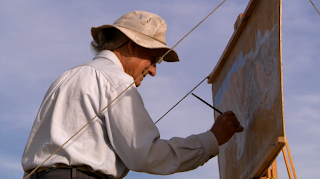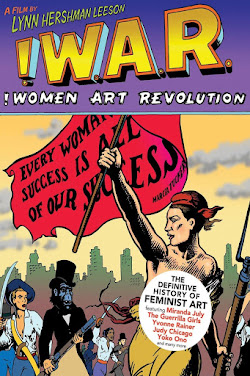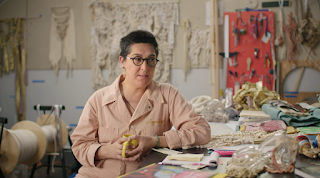Art21: "Balance" (S6, E2)
In this episode of Art21, the artists featured were Rackstraw Downes, Robert Mangold, and Sarah Sze, touching upon the idea of "balance."
Rackstraw Downes was born in Kent, England, and is often described to be a Realist Landscape painter. He doesn't precisely consider himself either of them, because to see and represent something are two acts that are culturally taught, and in terms of being a landscape painter, he said, "I don't think of myself as a Landscape Painter... I like to say I paint my environment, my surroundings... Surroundings implies that the landscape does really curve around you because I follow the curve. I see that curve also expressed this way on the canvas." As such, he sees himself as painting his surroundings and environment, all based upon a curve that is a trademark in his paintings. He feels that when you look at an artwork, you look at it through the "wandering eye," to which you look at it in parts until it forms a complete whole. Especially in terms of his "curve" compositions, our eyes do move around his work until we are able to see the "complete picture." Although many of his works convey a sense of perspective, Rackstraw isn't interested in focusing upon it, because as he said, "everything changes." However, he is fascinated with empty space and things that sound minuscule in his environment, like the markings on the floor or walls of a structure. To himself, "it looks empty, but I see fullness there. And I'd like you to see that fullness too in my painting." One work I wanted to highlight is his 110th and Broadway, Whelan’s from Sloan’s from 1980 and 1981 (pictured below). Although I understand that this isn't a landscape painting per-se, I really admired the sense of the city atmosphere. The city looks bright, and the brightness is conveyed beautifully by how the light glistens on the cars, streets, sidewalks, sky, and the people walking by. I found myself looking at this work from right to left, as the cars and people were moving toward that direction. I felt that I was physically in the city, walking around with the pedestrians walking past. The city feels welcoming and warm, all thanks to the atmosphere and empty space Rackstraw utilizes. It feels like an ideal day where you wake up and say, "it's a beautiful day, why not take a walk for a change?"
Sarah Sze is an Installation artist from Boston, Massachusettes. Her sculptures come from utilizing everyday objects and combining them together into a fantastical, architectural piece. Her work is meant to balance the ideas of fantasy with ecological themes of sustainability. These ideas as ever-present in her Still Life with Landscape (Model for a Habitat) that was present in the New York Highline from June 8th 2011, to June 6th 2012 (pictured below). It began when the New York Highline was set to be demolished, but public outcry convinced the city to let it remain and turn it into a park. To Sarah, "the piece that I conceived was a kind of habitat. You have all of these birds, butterflies, insects there, and I wanted to make a location where you would observe them on the high line." The piece also plays with the idea of one-point perspective, "to trick our eyes into seeing deep space," as she puts it. She liked the idea of putting her sculpture in a place that people would have to walk through, as the "walk" serves to be the sculpture's negative space. Therefore, the viewers themselves are viewing and participating within the sculpture. I found this work to be incredibly profound in its message of conservation whilst looking abstract and pleasing to the eye. I was a bit concerned that despite the work being a habitat for the birds and wildlife on the Highline, I was worried that maybe the birds might get hurt by the sharp points of it, as the metal points jut forward and at an angle toward the sky. However, upon Art21 showcasing this work and the birds sitting by the birdhouses, I supposed the work was safe enough for the birds. Besides, I also took heed that Sarah also heavily researched the birds and wildlife of the area, making sure that it was sustainable and allowed anyone to come and utilize it. This factor alone made me appreciate the work all the more, as not only did Sarah want to make something that was aesthetically pleasing to the people, she also didn't make the work too "industrial" for the wildlife to be strayed away. The work unified both the city and animals together harmoniously, and that is what I found to be the most important aspect of this work. Despite the Highline work being in a very populated area, most of her other works utilize spaces that go unnoticed or unoccupied. "Often, with my work, it'll be in a corner, or it'll be behind a stair, it'll be near the freight elevator, so that your experience of first is 'What is this?' For me, most interesting art always has that question in it."








Comments
Post a Comment